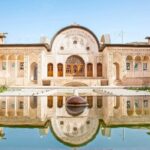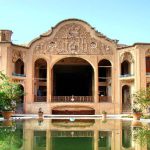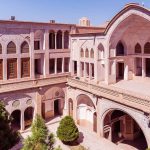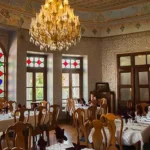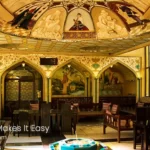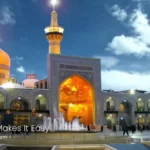The Fin Garden in Kashan is considered one of the top 9 Iranian gardens, recognized as a UNESCO World Heritage site, thanks to its unique and distinctive architecture. This beautiful garden is located in an ancient neighborhood of Kashan known as Fin. This garden is so stunning that it’s considered a perfect example of Iranian gardening. With its numerous fountains, the soothing sound of water, and towering trees, Bagh-e Fin is an enchanting place to explore. What makes it even more special is its teahouse (Chai Khane), where you can fully savor these serene moments.
Moreover, you’ll find many historical monuments worth visiting in the garden, such as Khalvat Karimkhani, Howz Jooshan, Qajar Shotorgalo House, a water divider, and the Kashan National Museum. Notably, one of the main reasons for Fin Garden’s fame is the historical event of Amir Kabir’s assassination, a prominent Prime Minister of Iran, which is a significant part of the garden’s history.
History of Fin Garden

Fin Garden in Kashan boasts a fascinating history, tracing its origins back to a time when Iran had a vast lake during wet periods, eventually transforming into a desert. However, the perennial Fin spring attracted early settlements.
This garden’s story is intertwined with various dynasties, including the Albooyehs, Ilkhanate, and Safavids. During the Safavid era, Kashan flourished as a center for Shia scholars and artisans, thriving economically when Isfahan became Iran’s capital. This prosperity led to the creation of numerous historical monuments in Kashan.
Tragedy struck during Shah Tahmasb’s reign with a major earthquake centered at Fin Garden, causing substantial damage. Subsequently, Shah Abbas I initiated extensive restoration and expansion efforts.
Over time, Fin Garden underwent multiple phases of repair and expansion, often aligned with changing rulership. The garden saw significant renovations during Fath Ali Shah Qajar’s rule, with many of the structures we see today dating from that era.
After the fall of the Qajar dynasty, the garden’s historical importance waned. Yet, during the Pahlavi era, it regained recognition as a national heritage site. Restoration began with the repair of the garden’s pool, followed by the establishment of a museum in 1957.
Post the Islamic Revolution, Fin Garden regained prominence, leading to modern restoration efforts and its designation as a UNESCO World Heritage Site in 2010. Today, it stands as a testament to Iran’s rich historical and natural heritage.
Architecture of Fin Garden

Fin Garden is a sprawling garden that follows all the standard principles of garden architecture. One of its striking features is the presence of trees and water, which are the lively and captivating elements of this place. Alongside other beautiful structures in this garden, they have created a unique and interesting architectural design. One notable engineering aspect in the design of Fin Garden is the preservation of its symmetry, which held special importance in the past. However, over time, with the involvement of rulers in the city, this symmetry decreased.
The passages within the garden play a significant role in its architecture. To the east and west, you’ll find the Amir Kabir Library and the Kashan National Museum. To the north and south, there’s the Sar-dar Mansion, and as you enter the south passage to the north, you can admire the Shotor Galou Mansion on the southern side.
Read More: List of Top Persian Gardens in Iran
Features of Fin Garden
Cheshme Joosh (Springing Water)
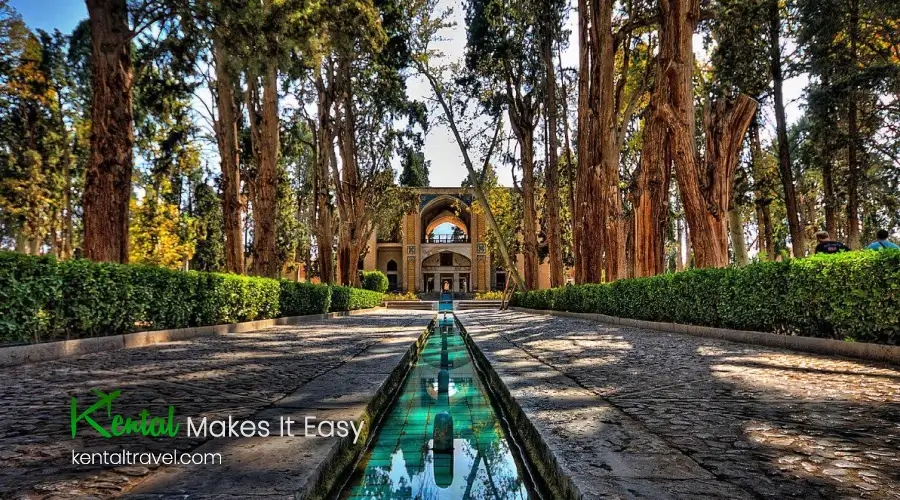
The “Cheshme Joosh” is one of the amazing parts of the Fin Garden that’s a real attraction for any tourist. The bottom of this pool is entirely covered in beautifully designed tiles that look similar to Kashan rugs. These tiles were actually taken from a private garden during the early days of Reza Shah’s reign. Although they didn’t have the skills to handle the intricate tile system, so most of them were useless, and some were even sold to the Louvre Museum in Paris.
The JouCheshme Joosh has 160 holes, each representing the flowers in a rug. What’s interesting about these holes is that when water spouted out from the first hole like a fountain, the second one acted as a water intake. As a result, half of the holes were for fountains, and the other half were for water intake. Since the water entered and exited uniformly, it never overflowed from the pool. These unique features make it a masterpiece of water art.
- In the Fin Garden, there’s a pond often referred to as the “Wishing Pond.” It is said that if you throw a coin into this pond, your wishes will come true. However, most tourists and visitors have filled the pond with various coins as a form of entertainment.
- This ancient belief in Iran, rooted in the Zoroastrian religion, regards water as a symbol of purity and illumination. Followers of Zoroastrianism used to offer a portion of their wealth to water goddesses to bring blessings and purity to their homes and pockets.
Read More: Historical Architecture Sites in Iran
National Museum of Kashan

This museum is located on the northwest side of the garden and was constructed from the ruins of the Khalvat-e Nizam al-Mulk building. The building covers an area of over 300 square meters and consists of several large and small halls, as well as a spacious basement.
The museum is divided into three sections: anthropology, archaeology, and handicrafts. The artifacts in this museum include 400 pieces of pottery (both pre-Islamic and post-Islamic), ceramics, clothing, calligraphy, and various textiles. The items in the archaeology section of the museum are the result of excavations conducted in Silk Hill, Chogha Zanbil, Hasanlu, Khurvin, and Lorestan.
Read More: Top Museums in Iran
Fin Bathhouse (Amir Kabir’s Assassination)

This bathhouse, known as the Finn Bathhouse because it’s located in the Finn Garden, is one of the most important parts of this garden. That’s because one of Iran’s most significant and maybe the most bitter historical events, the assassination of Amir Kabir, happened right here in this bathhouse.
In this garden, there were two bathhouses. One was the Royal Bathhouse, built by the order of Fath Ali Shah and meant for the Qajar kings. The other was the Safavid Bathhouse or the Small Bathhouse, where the assassination of Amir Kabir, Iran’s prominent prime minister, took place.
This bathhouse was constructed around the year 882 in the Persian calendar. The most remarkable thing about it, in terms of architecture, is the existence of seven ancient tiles that are 500 years old.
When is the Best Time to Visit Fin Garden?

The best time to visit Fin Garden would be during the spring and early summer months, typically from March to June. During this period, the weather is pleasant, and the garden is at its most vibrant with lush greenery and blooming flowers. It’s an ideal time to enjoy the beautiful architecture and serene atmosphere.
FAQs about Kashan Fin Garden
- Who built Fin Garden?
During the reign of Shah Abbas I, the development and expansion of the city of Kashan were put on the agenda, and the foundation for the construction of today’s Fin Garden was laid. Cultural heritage points to Ghiasuddin Jamshid Kashani as the designer of Fin Garden. He was a famous mathematician during the Safavid era. However, some experts consider Sheikh Bahai as the garden’s designer. - What’s the most significant historical event in Fin Garden in Kashan?
Undoubtedly, the assassination of Amir Kabir, Iran’s Prime Minister, in 1851 in the bathhouse of this garden, has been the most important and bitter historical event at this place. - Is Fin Garden open to the public?
Yes, Fin Garden is open to the public. There is an entrance fee for visitors, and it’s a popular attraction for tourists and locals alike. - How do I get to Fin Garden?
Fin Garden is easily accessible in Kashan, Iran, by car, taxi, or public transportation. Many local tour operators also include it in their itineraries. - Are guided tours available at Fin Garden?
Yes, guided tours are available for those who want to learn more about the history, architecture, and significance of the garden.


